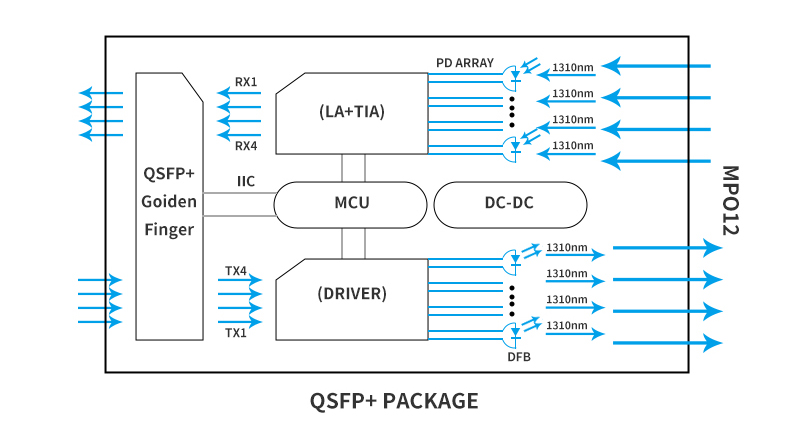

 Knowledge Base +
Knowledge Base +  2023.12.12
2023.12.1240G QSFP+ LR4 optical modules are widely used in 40G networks, which contain two types of 40G QSFP+ LR4 CWDM4 optical modules and 40G QSFP+ LR4 PSM4 optical modules. The former is used to connect WDM links and the latter is used to connect parallel single-mode fiber links, but what is the difference between these two types of modules?
First, CWDM4 and PSM4 both terminology analysis
CWDM (Coarse Wavelength Division Multiplexing) refers to Coarse Wavelength Division Multiplexing, CWDM is one of the WDM (Wavelength Division Multiplexing), can be in a single optical fiber on multiple channels to send and receive signals, usually used in point-to-point structured cabling in the communication network, multiplexed to a single-mode fiber through the CWDM method.
PSM4 (Paralell Single Mode 4 lanes) means Parallel Single Mode 4 lanes, a fiber optic data transmission standard.
Unlike CWDM optical modules that send or receive signals over multiple lanes on a single fiber, PSM can receive and send signals over four parallel fibers at the same time.
Overview and working principle of the two types of 40G QSFP+ LR4 optical modules
Overview of 40G QSFP+ CWDM4 Optical Module
40G QSFP+ LR4 CWDM4 optical module has LC duplex interface, four independent transceiver channels, each channel transmits data rate up to 11.2Gbps, conforms to QSFP+ MSA standard, conforms to IEEE 802.3ba specification of 40G LR4 link, and has four CWDM DFB lasers, with center wavelengths of 1270, 1290, 1310, and 1330nm. 1330nm. It is capable of supporting QDR/DDR Infiniband data rates, hot-swappable electrical interfaces, and low power consumption.
In addition, the 40G QSFP+ LR4 CWDM module must be used with single mode fiber and has a maximum transmission distance of 10km.
40G QSFP+ CWDM4 Optical Module Working Principle
The 40G QSFP+ CWDM4 Optical Module converts four channels of 10Gb/s electrical input data into CWDM optical signals (light) through an array of four drive lasers (DFBs). The light is combined into 40Gb/s data by the MUX component, which sends the optical signals from the single-mode fiber. The receiving end receives the 40Gb/s CWDM optical signal input and demultiplexes it into four separate 10Gb/s channels of different wavelengths.

40G QSFP+ PSM4 Optical Module Overview
The 40G QSFP+ PSM4 Optical Modules are four-channel, full-duplex transceiver modules. The QSFP full-duplex optical modules provide four independent transmit and receive channels, each capable of operating at 40Gbps 10km aggregated data rates at 10.3Gbps using single-mode fiber. These modules are designed to operate on singlemode fiber systems using 1310nm DFB laser arrays. Fiber ribbon cables with MPO/MTP connectors plug into QSFP module sockets with built-in digital diagnostics.
How 40G QSFP+ PSM4 Optical Modules Work
The 40G QSFP+ PSM4 Optical Module uses 4-way 10G parallel technology, which can be split into 4-way 10G links for transmission using MPO single-mode OS2 fiber optic patch cords. At the transmitting end, the electrical signal is converted into an optical signal by the laser array. When transmitting the signal at the transmitting end, the parallel optical signal is converted into a parallel electrical signal, which is then transmitted to the receiving end via fiber optics. At the receiving end, the photodetector array converts the parallel electrical signal back into a parallel optical signal, which is then transmitted to the transmitting end via fiber optics.
Third, the difference between 40G QSFP+ LR4 CWDM4 and PSM4 fiber optic modules.
40G QSFP+ CWDM4 and 40G QSFP+ PSM4 optical modules can be applied to long-distance transmission, but there are still differences in the interface, transmission distance, application scenarios and so on.
These two kinds of optical modules from the perspective of the infrastructure of the entire network system, when the fiber optic link is longer, the cost of using 40G QSFP+ LR4 PSM4 optical module will be a little higher, which requires the use of 8 single-mode fiber patch cords, while the 40G QSFP+ LR4 CWDM4 optical module requires only 2 single-mode fiber patch cords.

Subscribe to the newsletter
for all the latest updates.
2-5# Building, Tongfuyu Industrial Zone, Aiqun Road, Shiyan Street, Baoan District, Shenzhen. China
